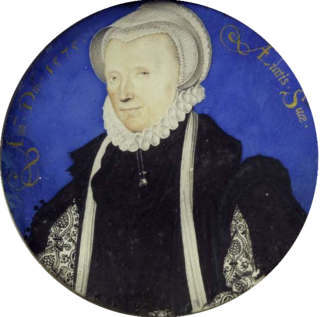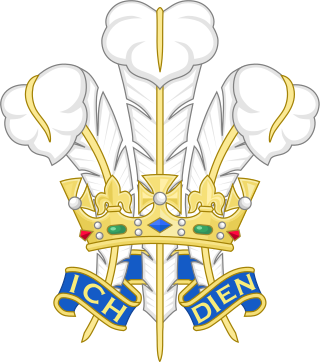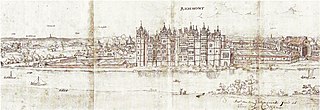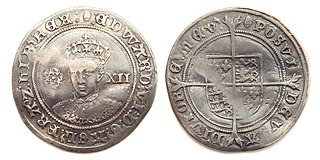
Katherine Seymour, Countess of Hertford was a younger sister of Lady Jane Grey.

Margaret Douglas, Countess of Lennox, was the daughter of the Scottish queen dowager Margaret Tudor and her second husband Archibald Douglas, 6th Earl of Angus, and thus the granddaughter of Henry VII of England. She was the grandmother of James VI and I.

The Crown Jewels of the United Kingdom, originally the Crown Jewels of England, are a collection of royal ceremonial objects kept in the Jewel House at the Tower of London, which include the coronation regalia and vestments worn by British monarchs.

St Edward's Crown is the centrepiece of the Crown Jewels of the United Kingdom. Named after Saint Edward the Confessor, versions of it have traditionally been used to crown English and British monarchs at their coronations since the 13th century.

The Imperial State Crown is one of the Crown Jewels of the United Kingdom and symbolises the sovereignty of the British monarch. It has existed in various forms since the 15th century. The 1937 version is worn by a new monarch for the first time in the royal procession following their coronation and subsequently used at State Openings of Parliament. The crown is adorned with 3,170 precious stones, including the Cullinan II diamond, St Edward's Sapphire, the Stuart Sapphire, and the Black Prince's Ruby.

The Black Prince's Ruby is a large, irregular cabochon red spinel weighing 170 carats (34 g) set in the cross pattée above the Cullinan II diamond at the front of the Imperial State Crown of the United Kingdom. The spinel is one of the oldest parts of the Crown Jewels of the United Kingdom, with a history dating back to the middle of the 14th century. It has been in the possession of England's rulers since it was given in 1367 to its namesake, Edward of Woodstock. The stone is believed to have originated from the Badakhshan mines in present day Afghanistan and Tajikistan, the principal source of large spinel gems in the Middle Ages.

Lady Mary Keyes was the youngest daughter of Henry Grey, 1st Duke of Suffolk, and Frances Brandon, and through her mother had a claim on the crown of England.

A heraldic badge, emblem, impresa, device, or personal device worn as a badge indicates allegiance to, or the property of, an individual, family or corporate body. Medieval forms are usually called a livery badge, and also a cognizance. They are para-heraldic, not necessarily using elements from the coat of arms of the person or family they represent, though many do, often taking the crest or supporters. Their use is more flexible than that of arms proper.

Frances Grey, Duchess of Suffolk, was an English noblewoman. She was the second child and eldest daughter of King Henry VIII's younger sister, Princess Mary, and Charles Brandon, 1st Duke of Suffolk. She was the mother of Lady Jane Grey, de facto Queen of England and Ireland for nine days, as well as Lady Katherine Grey and Lady Mary Grey.

The State Crown of George I is the imperial and state crown crafted in 1714 for King George I. It was modified and used by subsequent monarchs until 1838. The empty gold frame and its aquamarine monde which dates from the reign of King James II are both part of the Crown Jewels of the United Kingdom. They are on public display in the Martin Tower at the Tower of London.

The State Crown of Mary of Modena is the consort crown made in 1685 for Mary of Modena, queen of England, Scotland and Ireland. It was used by future queens consort until the end of the 18th century.

Richmond Palace was a royal residence on the River Thames in England which stood in the sixteenth and seventeenth centuries. Situated in what was then rural Surrey, it lay upstream and on the opposite bank from the Palace of Westminster, which was located nine miles (14 km) to the north-east. It was erected in about 1501 by Henry VII of England, formerly known as the Earl of Richmond, in honour of which the manor of Sheen had recently been renamed "Richmond". Richmond Palace therefore replaced Shene Palace, the latter palace being itself built on the site of an earlier manor house which had been appropriated by Edward I in 1299 and which was subsequently used by his next three direct descendants before it fell into disrepair.

In modern heraldry, a royal cypher is a monogram or monogram-like device of a country's reigning sovereign, typically consisting of the initials of the monarch's name and title, sometimes interwoven and often surmounted by a crown. Such a cypher as used by an emperor or empress is called an imperial cypher. In the system used by various Commonwealth realms, the title is abbreviated as 'R' for 'rex' or 'regina'. Previously, 'I' stood for 'imperator' or 'imperatrix' of the Indian Empire.

The Tudor Crown, also known as the Imperial Crown, is a widely used symbol in the heraldry of the United Kingdom. In use officially from 1902 to 1953 and again from 2022, it represents both the British monarch personally and "the Crown", meaning the sovereign source of governmental authority. As such, it appears on numerous official emblems in the United Kingdom, British Empire and Commonwealth.

The Mirror of Great Britain was a piece of jewellery that was part of the Crown Jewels of the United Kingdom during the reign of King James VI and I. It was pawned in 1625 and is considered lost.

The Three Brothers was a piece of jewellery created in the late 14th century, which consisted of three rectangular red spinels arranged around a central diamond. The jewel is known for having been owned by a number of important historical figures. After its commission by Duke John the Fearless of Burgundy, the jewel was part of the Burgundian crown jewels for almost 100 years, before passing into the possession of German banker Jakob Fugger.

The jewels of Anne of Denmark (1574–1619), wife of James VI and I and queen consort of Scotland and England, are known from accounts and inventories, and their depiction in portraits by artists including Paul van Somer. A few pieces survive. Some modern historians prefer the name "Anna" to "Anne", following the spelling of numerous examples of her signature.

An inventory of the jewels of Mary I of England, known as Princess Mary or the Lady Mary in the years 1542 to 1546, was kept by her lady in waiting Mary Finch. The manuscript is now held by the British Library. It was published by Frederic Madden in 1831. Some pieces are listed twice. Two surviving drawings feature a ribbon with the inscription, "MI LADI PRINSIS". The British Library also has an inventory of the jewels she inherited on coming to the throne in 1553.

The coronation of Edward VI as King of England and Ireland took place at Westminster Abbey, London, on 20 February 1547. Edward ascended the throne following the death of King Henry VIII.

Everard or Everart Everdyes was a London-based goldsmith and precious stone cutter or lapidary who worked for Henry VIII, Edward VI, and Mary I of England. In 1546, with a merchant partner Peter Vanderwalle, he received a licence to import a variety of luxury goods. Like Vanderwalle, he may have learnt his trade and craft in Antwerp, and was allowed to settle in London with his family in 1546.





















